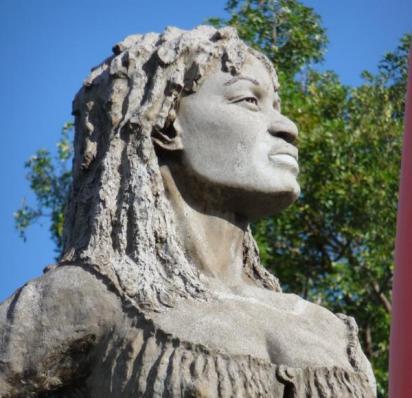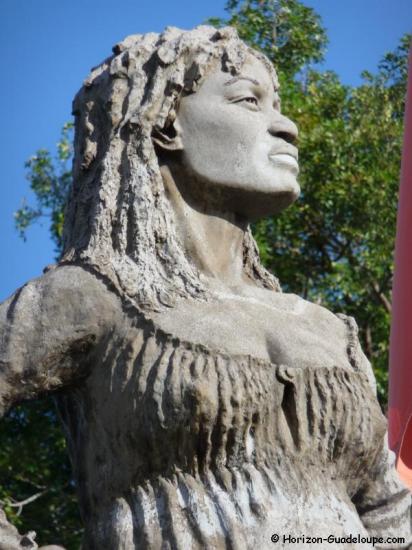Community news. A Woman Named Solitude: A brief history of the resistance to enslavement in Guadeloupe.
Throughout the enslavement of African people, women of African descent have always played their part in bringing down the institution of slavery. Some came from cultures where military disciplines were instilled in them and they used such knowledge to thwart their condition of enslavement. Others, who were knowledgeable in medicinal properties acted as healers for their people or were instrumental in concocting potions to poison their enslavers.
Some heroines occupy places of great importance in their country’s folklore and through migration; knowledge of those women has gained a wider audience. Many though who have fought for freedom and justice are rarely acknowledged outside of their own country. One such person is a Guadelopean woman named, Solitude.
The islands of Guadeloupe are located between Montserrat and Dominica in the Lesser Antilles. It consists of two main islands, Basse-Terre and Grande-Terre, and a number of smaller islands including, Marie-Galante, lles des Saintes and Les Désirade.
The official language is French. However, most people speak a Francophone Creole, which has a mixture of French, African, English, Carib, Spanish and Portuguese words. More than three quarters of the population of Guadeloupe are people of African descent.
In 1635, after centuries of resistance from the Kalinago (Carib) people, the French claimed the islands for France. In 1650, the first enslaved Africans arrived in Guadeloupe to work on the sugar plantations. Six years later, Guadeloupe had its first slave revolt, lead by Angolan captives.
Both the French and British wanted to control Guadeloupe for its resources and between 1759 and 1763, the island became the scene of many bloody battles between the two nations as they attempted to gain control of the trade in sugar, rum, tobacco and slaves.
The French Revolution (1789-1799) also affected those in the French Caribbean Islands and in 1791, Saint-Domingue (Haiti) was in the grips of the slave revolt, leading to the Haitian Revolution.
In 1793, the British attacked Martinique and Guadeloupe in their attempts to maintain slavery. They succeeded in Martinique but not in Guadeloupe. Over 1,500 men and enslaved people were able to repel the British military after seven months. In 1794, colonial administrator, and governor of Guadeloupe, Victor Hugues, abolished slavery on the island.
In 1802, with no hope of defeating Toussaint-Louverture in Saint-Domingue, Napoleon Bonaparte concentrated on brutally re-establishing slavery in Guadeloupe. Three thousand soldiers, under the command of General Richepance were deployed to Pointe-a Pitre, the capital of Guadeloupe to quell a slave revolt and in so doing, were responsible for the deaths of ten percent of the Guadeloupean population.
Advancing to the capital city, Richepance and his army slaughtered hundreds of men, women and children. To legitimize their actions and to subdue any pockets of resistance, those who fought for their freedom were labeled ‘rebels’ and survivors were publicly executed as warning examples.
Victims were tortured, roasted to death, sadistically mutilated or pulled apart on a wheel of torture. In Victory Square, Pointe-a-Pitre, 250 people were shot and a further 500 were rounded up on the beach and killed.
After Richepance died from Yellow Fever, Jean-Baptiste de Lacrosse took command and was responsible for an even more ferocious repression that sparked another uprising.
Journalist Christopher Hudson wrote in the Daily Mail in 2008: The ferocity of the repression sparked another uprising, which Lacrosse subdued with the most barbarous methods yet.
‘Being hung is not enough for the crimes they have committed,’ he said. ‘It is necessary to cut them down alive and let them expire on the wheel [prisoners were bound to a cart wheel before having their arms and legs smashed with cudgels].
‘The jails are already full: it is necessary to empty them as quickly as possible.’ In this, he was successful, hanging, garroting and burning the rebels and breaking their limbs on the wheel.
Lacrosse developed possibly the most fiendish instrument of slow execution ever created.
The prisoner was thrust into a tiny cage and had a razor-sharp blade suspended between his legs. In front of him was a bottle of water and bread, neither of which he could reach.
He was stood in stirrups, which kept him just above the blade, but if he fell asleep or his legs tired, he was sliced by the blade. Neither fast nor economical, it was pure sadism.
After four months in Guadeloupe, the French lost patience with the islanders, and the ferocity of their repression reached new heights.
Blacks with short hair were shot out of hand, since the expeditionary force considered short hair to be a sign of rebellion. Orders were given that ‘the type of execution should set a terrifying example’.
The soldiers were encouraged to cut open insurgents, to strangle and to burn them’. French officers spoke proudly of creating ‘torture islands’.




